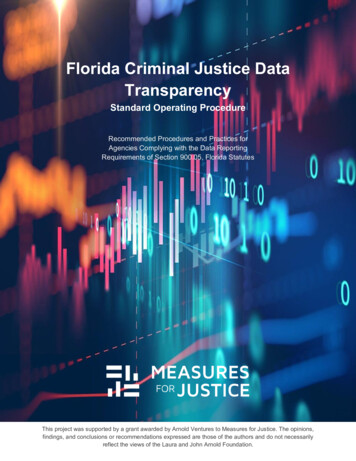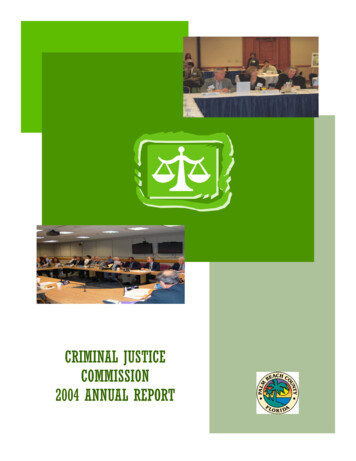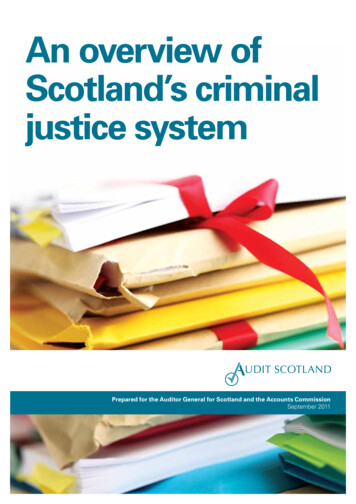
Transcription
Florida Criminal Justice DataTransparencyStandard Operating ProcedureRecommended Procedures and Practices forAgencies Complying with the Data ReportingRequirements of Section 900.05, Florida StatutesThis project was supported by a grant awarded by Arnold Ventures to Measures for Justice. The opinions,findings, and conclusions or recommendations expressed are those of the authors and do not necessarilyreflect the views of the Laura and John Arnold Foundation.
Table of ContentsList of Tables . 4Executive Summary . 5Acknowledgements . 6Introduction . 7Chapter 1: Business Process for Data Elements . 81.1.Is the data element being collected? . 81.2.What process could be created to collect data elements? . 81.3.Are data elements in the required format for transmission to FDLE? . 101.4.Self-Assessment Flowchart . 11Chapter 2: Data Element Definitions & Schemas . 122.1.Individual Agency Meetings . 122.2.Data Element Definition Workshops . 132.3.Schemas . 152.4.Chapter 2 Summary . 21Chapter 3: Structuring for Data Extractions . 233.1Data Structuring Goal . 233.2.Firming the Foundation . 243.3.Data Preparation . 253.4Automation & Standardization . 343.5Chapter 3 Summary . 37Chapter 4: Data Extraction Translation & Validation . 384.1.Understanding the Specification . 384.2.Translating Data into XML . 524.3.Local Validation . 544.4.Transmitting Data to FDLE . 574.5.Chapter 4 Summary . 59Chapter 5: Improving Data Culture . 615.1Introduction . 615.2Definition of Data Culture . 611
5.3Ten Commandments for Creating and Improving Data Culture . 625.4Case Studies in Implementing and Improving Data Culture . 645.5Importance and Value of Data . 705.6Avoiding Biases and Establishing Trust . 725.7How to Develop and Nurture Data Culture in Your Agency . 745.8Chapter 5 Summary . 77Chapter 6: Data Visualization and Publication . 786.1.Why is Data Visualization Important? . 786.2General Guidance for Data Visualization and Publication . 826.3.General Guidelines for Progressive Disclosure . 846.4.Deciding Which Visual is Best . 866.5.Data Publication and Suppression Rules . 886.6.Chapter 6 Summary . 89Conclusion. 90References . 92End Notes . 972
Table of FiguresFigure 1. Agency Self-Assessment Flowchart . 11Figure 2. Relationships of Elements . 17Figure 3 Cardinality Relationship . 18Figure 4 Relationship Values . 19Figure 5 Complicated Data Relationships . 20Figure 6 Arrest Date Collection Path Example . 28Figure 7 Data Conversion . 30Figure 8 Process Blocks . 34Figure 9 Data Collection & Preparation . 35Figure 10 Sample Hierarchy of CJDT XML Objects*. 39Figure 11 DED Person Record . 41Figure 12 Truncated XML from the IEP Sample Document of the Person Source Class . 44Figure 13 IEP Sample Code for an Alias . 45Figure 14 Visual Representation of an Alias Association . 45Figure 15 Code for an Alias Association . 46Figure 16 Finding Corresponding Code Values . 50Figure 17 Code Values and Descriptions . 50Figure 18 Visual Representation of CJDT XML Basic Structure . 52Figure 19 Expansion of TIDE Process Illustration . 54Figure 20 XML Notepad Main Interface . 55Figure 21 XML Notepad Schemas View . 56Figure 22 ICD Wrapper Hierarchy . 58Figure 23 TIDE Transmission Components . 59Figure 24 The Insight-Driven Organization Maturity Scale . 62Figure 25 The Knowledge Pyramid . 71Figure 26 Visualization Example . 79Figure 27 Spreadsheet Compared to Data Visualization . 80Figure 28 Sample of a Pie Chart . 81Figure 29 Example of Time Series Trends . 82Figure 30 Progressive Disclosure . 83Figure 31 Primary and Secondary Objectives . 853
List of TablesTable 1 Relationship Definitions . 19Table 2 Element to CMS Example . 25Table 3 Mapping Spreadsheet Sample for Sample Data Elements . 42Table 4 Cardinality of an Alias Association and Related Data Elements . 47Table 5 Mapping Spreadsheet Sample of Target Information. 49Table 6 Ten Commandments for Creating and Improving Data Culture . 63Table 7 U.S. Government Data Commitment Example . 64Table 8 State of Colorado Data Commitment Example . 65Table 9 State of Connecticut Data Commitment Example . 66Table 10 State of Pennsylvania Data Commitment Example. 66Table 11 County of Miami-Dade Data Commitment Example . 67Table 12 City of Boston Data Commitment Example . 67Table 13 City of Cape Coral Data Commitment Example . 68Table 14 City of Detroit Data Commitment Example . 69Table 15 City of Fort Lauderdale Data Commitment Example . 69Table 16 Developing and Nurturing Data Culture. 744
Executive SummaryThe Florida legislature passed a Criminal Justice Data Transparency (CJDT) bill in2018, enabling Florida to become a national leader in criminal justice transparency. Thebill standardized and centralized case-level criminal justice data from agencies in all 67counties, requiring criminal justice agencies to submit data to the Florida Department ofLaw Enforcement (FDLE). Along with other responsibilities, FDLE was required tocreate a complex data portal available to the public. A “pilot initiative” was established inthe Sixth Judicial Circuit, encompassing Pasco and Pinellas Counties. Measures forJustice (MFJ), with the support of Arnold Ventures, was selected to facilitate the projectwith its data expertise and employment of embedded data fellows. This StandardOperating Procedure (SOP) documents the lessons learned from the pilot initiative andoffers recommendations on the steps all agencies required to report to FDLE can taketo implement the mandate.Chapter one explains the business process used to identify and collect data elements.Some data elements were being collected prior to the CJDT initiative while othersneeded a collection and recording process to be created. Chapter two discusses dataelement definitions and the schemas needed for data collection. Several meetings withthe agencies were held to determine existing data elements, define additional dataelements needed, and characterize data schema descriptions with a strong emphasison standardization. Chapter three clarifies the structure necessary for data extraction.The variety of agencies involved, and their numerous computer systems, made itessential to have a united, automated, and standardized data structuring goal. Chapterfour demonstrates the data extraction translation, validation, and transmission process.Detailed translation instructions, validation methodology, business rules, and dataformatting are contained within this chapter. Chapter five emphasizes the importance ofembracing a data culture within each organization, allowing facts to direct decisionmaking. Chapter six outlines the value of data visualization and the importance of datapublication. Communicating the story to others is easier and more memorable with datavisualization.Measures for Justice believes when there is no data, there is no change. True andaccurate data can restore trust in the community and allow government to makeinformed decisions.15
AcknowledgementsThis document synthesizes information compiled throughout the three years Measuresfor Justice offered CJDT implementation support to the criminal justice agencies inPasco and Pinellas. The work this SOP is based on would not have been possiblewithout the generous support of Arnold Ventures. Furthermore, MFJ is grateful for theinput and feedback provided by local and state criminal justice agencies in Floridathroughout the course of this grant. Without their expertise and support we would nothave been able to create this document. Florida Clerk Technology GroupFlorida Court Clerks and Comptrollers AssociationFlorida Criminal and Juvenile Justice Information Systems CouncilFlorida Department of Corrections, Region IIIFlorida Department of Law EnforcementHernando County Clerk of CourtHillsborough County Clerk of Court and ComptrollerLee County Clerk and ComptrollerManatee County Clerk of the Circuit Court and ComptrollerMarion County Clerk of Court and ComptrollerPasco County Clerk and ComptrollerPasco Sheriff’s OfficePinellas County Business Technology ServicesPinellas County Clerk of the Circuit Court and ComptrollerPinellas County Justice CoordinationPinellas County Sheriff’s OfficePublic Defender, Sixth Judicial CircuitSeminole County Clerk of the Circuit Court and ComptrollerSixth Judicial Circuit of FloridaState Attorney, Sixth Judicial CircuitWalton County Clerk of Courts and ComptrollerFinally, MFJ would like to acknowledge the hard work and contributions to this projectmade by our Data Fellows: Ariel FonticiellaDeSean LewisPaula O’NeilSam Harden6
IntroductionDuring Florida’s 2018 legislative session, the legislature passed Senate Bill 1392,making Florida a national leader in criminal justice transparency.2 The legislation wasambitious in its scope, proposing to standardize and centralize case-level criminaljustice data from agencies in 67 different counties. Clerks of the Circuit Court (Clerks),State Attorneys, Public Defenders, Regional Conflict, Jail Administrators, and theFlorida Department of Corrections (DOC) were required to submit specific sets of dataabout each case and defendant. The Florida Department of Law Enforcement (FDLE),Florida’s statewide executive branch law enforcement agency, was ordered to collectthe data and publish it in “a modern, open, electronic format that [would be] machinereadable and readily accessible by the public on the department’s website.”3The legislation created a Pilot Project in the Sixth Judicial Circuit, encompassingPinellas and Pasco Counties. Both counties received assistance from Measures forJustice (MFJ), a non-partisan, non-profit organization with a mission to bring datatransparency to the criminal justice system, at no net cost to the counties. The workproduct of the Pilot Project was intended to inform and serve as a template for othercounties in the state.Part of MFJ’s work with the Pilot Project involved creating a Standard OperatingProcedure (SOP) document with guidelines for collecting, standardizing, andtransmitting data to the FDLE. The goal was to provide agencies across the state withthe tools to comply with the CJDT requirements, including establishing and nurturing adata culture and demonstrating various methods of data visualization. Some chapterswere previously released to help the remaining Florida agencies prepare their offices forCJDT compliance.7
Chapter 1: Business Process for Data ElementsThe first step in developing a comprehensive business process to comply with CJDTinvolved an agency self-assessment to identify the status of each of the data elementsrequired by the law. During that stage, it is helpful to refer to the following questionframework. These questions are not intended to be exhaustive; rather, they serve as thestarting point for agency self-assessment.1.1.Is the data element being collected?Many of the required data elements were already included in existing datastreams, such as the Offender Based Transaction System (OBTS) and theComprehensive Case Information System (CCIS). The CJDT legislation,however, included some elements and complexity not contemplated bypreexisting systems.1.2.What process could be created to collect data elements?To develop a process to record data elements not being collected, agencies mustdetermine the data element definitions, the level at which the data elements mustbe collected, whether they can be collected directly or inferred from other piecesof information, and whether they are being collected in the case managementsystems (CMS) or if new fields would need to be added.1.2.1. Is there a definition for the data element? Many of the data elements weredefined in Section 900.05, F.S., within the Data Dictionaries published bythe FDLE, or in both. Although most data elements were defined, edgecases created uncertainty. For example, the FDLE Data Dictionary for theClerks defined “trial type” as “the type of trial that was held for a case,”and allowed for three value options: None, Jury Trial, or Non-Jury.However, it was unclear how to classify a case where voir dire (juryselection) took place, and a jury was empaneled and sworn in, but thedefendant pleaded guilty before opening arguments or in the middle of thecase.1.2.2. What is the level at which the data element must be collected? Is it at thedefendant, case, charge, or agency-level? This question is important inconsidering where to source each data element. By virtue of their differentroles in the criminal justice process, agencies would have either direct orindirect access to information about the defendants, the cases, thecharges, and agency-level workload elements. For example, the county8
detention facility has direct interaction with many defendants through thearrest and booking process while other agencies typically do not have anydirect interaction with defendants. That creates unique challenges forreporting and originating defendant-centric data elements, such as thedefendant’s primary language.1.2.2.1.Data about defendants: Does the agency interact with thedefendant during the case process? If there is direct interaction,what is the protocol when the defendant refuses to divulgeinformation?1.2.2.2.Data about cases and charges: The stage of the charging or courtprocess should be considered for these data elements, as thatwould affect the collection process. For example, the domesticviolence flag element can only be evaluated once charges are filed,while the sentencing elements can only be evaluated in caseswhere sentencing has occurred.1.2.2.3.Workload elements: The reporting requirements for agencies likethe State Attorney’s office included many workload data elements,such as the number of full-time prosecutors or the annual felonycaseload. Some workload elements required unique extractionprocesses and some calculation to report accurately.1.2.3. Does the agency collect the data element directly, or does it need to beinferred from indirect indicators? As stated above, some agencies do nothave a regular, direct interaction with the original sources of some dataelements. For those data elements, it is important to consider whether theelement could be inferred from other data sources with a high degree ofconfidence. As an example, the Clerks must report the primary languageof each defendant; however, the Clerks do not typically interact with eachdefendant to gather that information. Many Clerks record when thedefendant requires an in-court language interpreter, which could beconsidered a reliable indicator that the defendant’s primary language isnot English.1.2.4. Is there a place to store the data elements in the case managementsystems (CMS)? Many agencies’ systems have capacity for the storage ofadditional data elements that were not already collected by thoseagencies. However, each agency has to consider the workload in both9
inputting and extracting the information for reporting. While a free-text notefield might be a convenient place to input a data element, it wouldincrease staff workload for extraction and automation.1.3.1.2.4.1.If there is no place to store the data element in the CMS, should theagency contract its vendor to modify the CMS? All vendor upgradesor modifications to agency systems can be expensive and timeconsuming. Each agency needs to weigh the pros and cons ofvendor vs. in-house solutions. In 2019, the Florida Legislatureauthorized grant funding, managed by FDLE, to help reportingagencies offset or reduce upgrade costs. In cases where vendorsrepresent multiple counties, agencies could consider coordinatingefforts across counties.1.2.4.2.Can the agency find an in-house solution to extract, translate, store,and transmit the data elements while ensuring consistent datacollection? An in-house solution could include the development of acustom-coded tool that performs all or part of the followingprocesses: extracting data from the agency’s database, translatingthe data into the format required by FDLE, and storing it, ifnecessary, until the time for transmission. The viability of in-housesolutions would depend on multiple factors, including, but notlimited to, staff time, funding, the agency’s technical expertise, andthe complexity of the agency’s technical infrastructure.Are data elements in the required format for transmission to FDLE?While many of the data elements were being reported through OBTS and CCIS,those reporting mechanisms used a different data format than the one specifiedby FLDE for CJDT reporting. Each agency needs to assess its capacity for datatranslation into the NIEM XML format for CJDT reporting and create a process toconform with that format. Further discussion about NIEM XML and its use isdiscussed in Chapter 4: Data Extraction Translation & Validation.10
1.4.Self-Assessment FlowchartFigure 1 illustrates the process each agency should undertake to assess itscurrent ability to collect and report each of the CJDT data elements to FDLE.Figure 1. Agency Self-Assessment FlowchartDo we collectthis element?What processes areneeded to collect adInformationDoes agencyinteract withdefendant?YesWhat elementsare needed tocalculate?Can we get it directly?If not, from what indicators?Is it in the rightformat for FDLE?YesYesNoWhat proceduredo we need toput in rightformat?Is there a place tostore in CMS?NoDo we engage withvendor or findsolution in-house?Move to the next stage11
Chapter 2: Data Element Definitions & SchemasEach pilot county was tasked with creating uniformity in the data being collected fromtheir county’s criminal justice system to effectively track statistical data on criminal caseprocessing. This chapter offers guidelines to achieve uniformity in the collection ofcriminal justice data on a county-by-county basis. It also offers a process to reachconsensus around data element definitions, as well as the data structure needed tomeet the mandate. This is not intended to be exhaustive, and the process will likely varyfrom county to county. However, it may serve as a starting point for any county to selfassess its own data collection process and begin preparing solutions for anyforeseeable issues that may arise as the project continues to progress.2.1.Individual Agency MeetingsTo create an integrated system that effectively tracks statistical data from criminalcase processing, it is important to understand what system each agency uses forits data collection and how those systems transmit data between agencies. Thatinvolves a review of how each required data element is defined and collected. Inthe pilot counties, meetings were held as soon as the legislation passed todiscuss definitions and sources. Data fellows joined the meetings as soon as theywere hired. Through that process, each agency identified known problem areas toavoid future complications and began crafting solutions. Below is a nonexhaustive list of questions that the agencies used to identify potential issues andsolutions.2.1.1. What system does the agency use? Is it integrated or non-integrated? Forexample, Pinellas County uses a centralized, integrated system thatshares a common database between different justice domain agencies,and that is managed and maintained by the county’s Business &Technology Services team (“BTS”). A data element such as “defendant’sdate of birth” is shared as a common database entry between multipleagencies (the offices of the Clerk, State Attorney, County DetentionCenter, and Public Defender). In practical terms, that means that ratherthan each agency's technology department reporting its required dataelements separately, the county’s BTS team will report the data on behalfof the Pinellas agencies from the centralized database source.2.1.2. Which data elements exist within the agency’s system? There are twoissues to consider when addressing this question. First, which dataelements are collected and stored within the agency’s database?12
Secondly, is the agency’s database configured to store the data element?It was discovered that some data elements required by the legislationwere not present in some agency systems, specifically, citizenship,primary language, and flag-designation elements.2.1.3. Which agency is the most appropriate source for collecting specificelements? Considerations for addressing this question include whetherthe agency originated a particular data element, or whether the agencywas closest to the source of the data element. One example discoveredwas the data element for defendant citizenship, as it was reported by boththe Clerk and the County Detention Center. The Detention Center,however, is better equipped to source that information because it hasdirect access to the defendant and access to federal immigrationdatabases and agencies.2.2.Data Element Definition WorkshopsWorkshops were conducted with all partner agencies in the two counties toagree on uniform definitions for each data element. The feedback providedduring those workshops was aggregated into a single document, which wasprovided to the Florida Legislature as the basis for the creation of a clean-upbill, and to the Florida Department of Law Enforcement, to assist with the datadictionary develop
2018, enabling Florida to become a national leader in criminal justice transparency. The bill standardized and centralized case-level criminal justice data from agencies in all 67 counties, requiring criminal justice agencies to submit data to the Florida Department of Law Enforcement (FDLE). Along with other responsibilities, FDLE was required to










